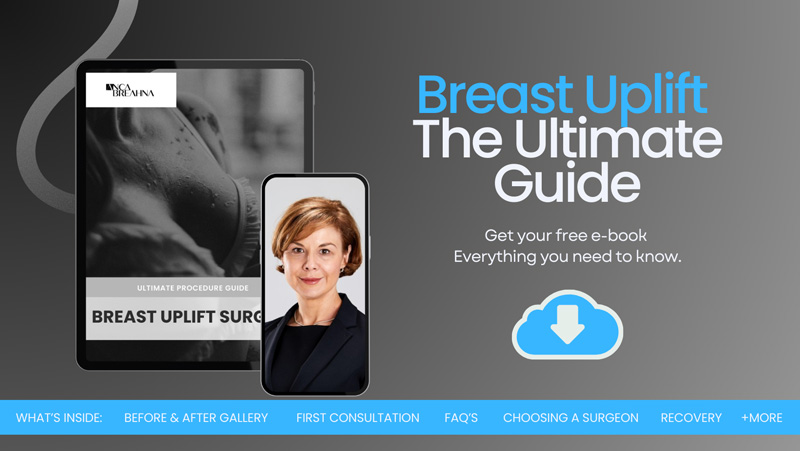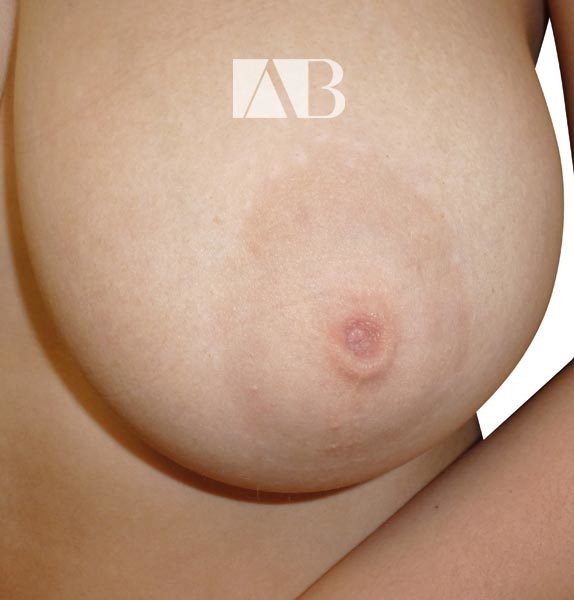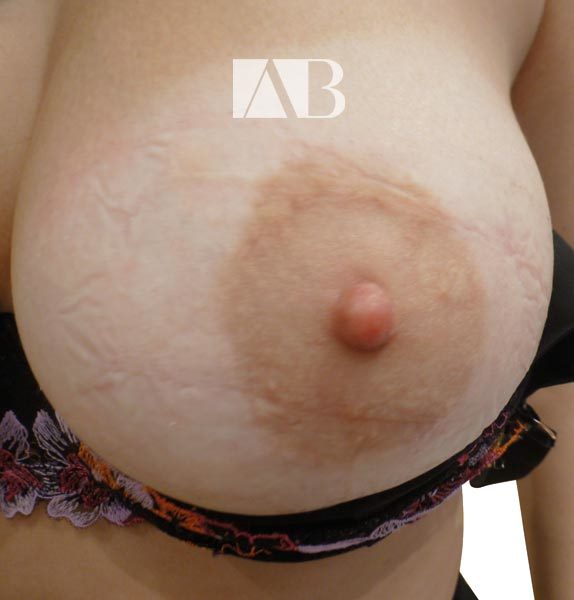Procedures
Inverted Nipple Correction

What Is Inverted Nipple Correction?
Inverted Nipple Correction Surgery is a cosmetic procedure performed to correct inverted nipples, which can be a significant concern for some individuals. This condition is characterised by nipples that retract into the breast rather than protruding outwards, affecting either one or both breasts. The severity of nipple inversion varies, classified into grades based on how easily the nipple can be made to protrude and its ability to maintain projection. The surgical correction not only aims to improve the aesthetic appearance of the breasts but also seeks to enhance nipple functionality, which may include the ability to breastfeed.
The appearance of the body can be sensitive to many people, especially when they are affected by a concern that is not considered the norm, such as inverted nipples. This condition is often present at birth, and describes nipples that do not protrude from the breast, but lie flat or retract inwards.
Chester Cosmetic Surgery can eliminate this concern with inverted nipple correction; a procedure that can address one or both of the nipples. This surgery is often considered when other forms of correction (such as Niplette suction device) have proved unsuccessful. During the procedure a small cut is made in the outer border of the nipple. This allows for the ducts to be stretched or divided, releasing constricted tissue so the nipples can protrude. The nipple may then need to have sutures or a special dressing applied to hold the nipple in place while it heals.
Women who consider inverted nipple correction can often be worried that they will not be able to breastfeed after having this surgery. This will be discussed at the consultation, and will depend on the extent of the concern and the technique that will be used. However in many cases, the concern itself can be the cause of difficulty when breastfeeding.
Download Miss Anca Breahna Breast Uplift Guide

At a glance
45 minutes
Local anaesthetic
24 hours
Natural looking nipples
Table of Contents
Who Needs Inverted Nipple Correction Surgery?
Inverted nipple correction surgery is primarily sought by people who experience discomfort or self-consciousness due to the appearance of their inverted nipples. This condition can be present from birth (congenital) or develop later in life due to various factors such as significant weight fluctuations, breastfeeding, or certain medical conditions. The surgery is considered a viable option for those looking for a permanent solution, as alternative non-surgical methods often provide only temporary results.
Candidates for this surgery should be in good overall health, with no active infections or untreated breast conditions. Smoking can significantly impair healing and increase the risk of complications, so you are advised to quit smoking well in advance of the procedure. It’s also crucial for candidates to have realistic expectations regarding the outcomes of the surgery, understanding that while the procedure aims to improve the appearance and functionality of the nipples, individual results can vary.
Benefits of Inverted Nipple Correction Surgery
The benefits of undergoing inverted nipple correction surgery extend beyond the aesthetic enhancement of the breasts. The procedure offers several advantages:
- Improved Aesthetic Appearance: The primary benefit is the correction of the nipple’s position, resulting in nipples that project outward in a natural manner. This change can significantly enhance the overall appearance of the breasts, contributing to a more traditional aesthetic.
- Boosted Self-Esteem and Confidence: Many patients with inverted nipples feel self-conscious about their appearance, which can affect their self-esteem and confidence. The correction of this condition can lead to a significant boost in how individuals perceive themselves and their bodies.
- Enhanced Nipple Sensitivity and Functionality: The procedure can improve the sensitivity of the nipples and their overall functionality. For some, this means an increase in sexual satisfaction due to the heightened sensitivity. Additionally, the correction can make breastfeeding possible for women who were previously unable due to severe nipple inversion, although this depends on the specific technique used and whether milk ducts are affected during the surgery.
- Minimal Scarring and Quick Recovery: Inverted nipple correction surgery results in minimal scarring, as incisions are made in discreet locations. The recovery period is relatively short, with most patients able to resume normal activities within a week, although full healing and final results can take several months to manifest.
- Long-Lasting Results: While non-surgical treatments for nipple inversion may offer temporary solutions, surgical correction provides a permanent fix for the condition, giving you long-lasting satisfaction with the results.
Procedures
Before & After
See the difference Inverted Nipple Correction
has made for our clients
Types of Inverted Nipple Correction Surgery
Simple Release Technique
The simple release technique is often used for mild cases of nipple inversion (Grade 1). This method involves making a small incision at the base of the nipple. Through this incision, Anca carefully cuts the shortened ducts and fibrous bands that are pulling the nipple inward. The goal is to release the tension that causes the nipple to retract while minimising damage to the milk ducts, preserving the patient’s ability to breastfeed, if desired. This technique is favoured for its simplicity and effectiveness in cases where the inversion is not caused by severe fibrosis or significantly shortened ducts.
Purse-String Technique
For more severe cases of nipple inversion (Grade 2 and Grade 3), the purse-string technique may be employed. This method involves placing a suture around the base of the nipple in a circular pattern. The suture acts like a purse-string, gently pulling and securing the nipple in an outward position. Depending on your needs and the extent of the inversion, Anca may also release fibrous bands and ducts to allow the nipple to protrude more naturally. This technique can be more invasive than the simple release and may impact the milk ducts, potentially affecting breastfeeding capability. It’s particularly useful for patients with significant fibrosis or those who have not achieved lasting results with less invasive methods.
Fat Grafting
Fat grafting is a technique that can be used alone or in conjunction with other methods, such as the simple release or purse-string techniques, especially in cases where there is a lack of volume in the nipple or areola. This procedure involves harvesting fat from another area of the body (such as the abdomen or thighs) through liposuction. The fat is then processed and injected into the area around the nipple, providing additional volume and support to help maintain the nipple’s protrusion. Fat grafting can enhance the aesthetic outcome of the correction, offering a more natural and fuller appearance to the nipple and areola complex. However, it requires careful consideration and skill to ensure a harmonious and lasting result.
Combination Techniques
In some cases, a combination of the above techniques may be necessary to achieve the best results. For example, Anca might use the simple release method to cut the fibrous bands and then apply the purse-string technique to secure the nipple’s position. If additional volume is needed to support the correction or improve the aesthetic appearance, fat grafting may also be incorporated into the procedure. The choice to combine techniques is based your anatomy, the severity of the nipple inversion, and the specific goals for the surgery.
Inverted nipple correction surgery is tailored to address the specific degree of nipple inversion, which is typically classified into three grades. The procedure’s complexity can vary based on the grade, with higher grades often requiring more intricate techniques to achieve a lasting correction.
- Grade 1: Nipples that are easily pulled out but retract due to loose connective tissue.
- Grade 2: Nipples that can be pulled out but have more resistance and tend to retract more quickly.
- Grade 3: Nipples that are severely retracted and cannot be pulled out manually, often due to tightly contracted ducts or fibrous tissue.
The surgery is usually performed under local anaesthesia with sedation or under general anaesthesia, depending on your comfort and the extent of the procedure. The goal is to release the fibrous bands and ducts that pull the nipple inward, allowing it to protrude naturally. Techniques vary from simple release methods to more complex procedures involving sutures or even fat grafting to support the nipple’s new position and enhance its appearance.
The choice of technique is a critical decision made in consultation with Anca. The procedure typically takes 1 to 2 hours and is often performed on an outpatient basis, allowing you to return home the same day.
Inverted nipple correction surgery is tailored to address the specific degree of nipple inversion, which is typically classified into three grades. The chosen surgical technique depends on the severity of the inversion, your anatomy and personal and functional goals.
Recovery and Aftercare
The recovery process from inverted nipple correction surgery is generally quick and with minimal discomfort. Most patients can return to work and resume light activities within a few days, although it’s recommended to avoid strenuous exercise and heavy lifting for a few weeks to facilitate healing.
Immediately following the surgery, you may experience swelling, bruising, and sensitivity in the treated area. These symptoms are normal and usually subside within a few weeks. Pain medication can be prescribed to manage any discomfort during the initial recovery phase.
Adhering to Anca’s aftercare instructions is crucial for a smooth recovery and optimal results. This includes wearing any recommended support garments, keeping the surgical area clean and dry, and attending all follow-up appointments. You will also be advised to avoid smoking and limit alcohol consumption, as these can impair healing and increase the risk of complications.
The final results of the surgery will gradually become apparent as the swelling decreases, usually within a few months. While scars are minimal and strategically placed to be less noticeable, they will continue to fade and improve over time.
Reviews
Patient satisfaction is the top priority for Anca. You can find how patients feel about her work below.
I’m thrilled with my results ! Having thoracic issues for 20+ years, I eventually decided on breast reduction surgery. Miss Breahna was extremely helpful and explained the process/ procedure thoroughly at every step. The aftercare has also been exceptional with regular review appointments. I am now 14 weeks post surgery and am delighted with the results having gone from an F cup down to a D. My back pain has significantly improved and I am no longer self conscious about my large breasts. Already the scars around my nipples have disappeared and my other scars are fading nicely too. I would recommend Miss Breahna wholeheartedly, to anyone considering similar surgery.

Miss Breahna was incredible! I went to her for a breast reduction surgery and she was so caring and understanding and did such a wonderful job. I felt really listened to over what I wanted and very well informed. I’m so pleased with the results, it’s genuinely been a life changing surgery for me. Her secretary was also amazing and made it really easy to reach Miss Breahna with any questions or concerns I had. I’d highly recommend!

Having considered breast reduction surgery for many years I’d say to anyone reading this, don’t hesitate to book a consultation with Anca. From the moment I met her she put me at ease, answered all my questions and has totally changed my life. The pre and post operative care has been outstanding as was my hospital care too.I just wish I had done it sooner!
Pricing & Funding for Inverted Nipple Correction Surgery in the UK
The cost of inverted nipple correction surgery in the UK is influenced by various factors, including the specific technique used, the surgeon’s experience, and the location of the clinic or hospital. On average, the price range for this procedure can vary from £2,000 to £4,000. This estimate usually covers the surgeon’s fee, anaesthesia, the use of the facility, and follow-up appointments. However, additional costs may arise for medication, special garments, or unforeseen complications, making it essential to discuss all potential expenses Anca’s team during the consultation process.
When considering the financial aspect of inverted nipple correction surgery, it’s important for patients to explore all available funding options. In the UK, the National Health Service (NHS) may cover the cost of the procedure in cases where the condition causes significant physical discomfort or psychological distress. However, such cases are rare, and the majority of patients will find this procedure categorised under cosmetic surgery, which is not typically funded by the NHS.
Private health insurance may offer another avenue for funding, although coverage varies significantly between policies. Some insurers may cover the procedure if it can be demonstrated that the condition is causing physical health issues or significant psychological distress. Patients are advised to carefully review their insurance policy and discuss their situation with their insurer to understand the extent of their coverage.
Further Reading
- Read Anca’s Blog on How to Fix Inverted Nipples

Procedure
Frequently asked questions
Am I suitable for inverted nipple correction?
Discussing your concerns at a pre-treatment consultation will establish if the procedure will be a suitable option. Both men and women can benefit from this procedure when they are affected by inverted nipples, as it creates a more natural look to the breasts.
Is this procedure safe?
This is a very safe procedure and one that Miss Breahna has undertaken many times. If it is felt that the surgery will compromise your health and / or well-being Chester Cosmetic Surgery will not recommend it for you.
Will this procedure hurt?
As the procedure will cause some degree of pain, you will be given the most appropriate form of anaesthesia, which is usually a local anaesthetic.
Are there any side effects or risks?
The main side effect to consider when having inverted nipple correction is the inability to breastfeed, as the procedure involves the division of the milk ducts. Swelling and bruising is to be expected after the procedure. There may also be a scar left behind, but this usually goes unnoticed. Occasionally the nipple can invert again, but for many patients only 1 procedure is required.
When will I see the results?
As this is a fairly straightforward procedure the nipples usually heal quite quickly. You can expect the full outcome to be visible within 4-6 weeks.
What are the risks associated with inverted nipple correction surgery?
As with any surgical procedure, there are inherent risks, including infection, bleeding, adverse reactions to anaesthesia, and complications related to the surgery itself. Specific to inverted nipple correction, there is a risk of loss of nipple sensitivity, difficulty breastfeeding, and asymmetry between the nipples. Discussing these risks with Anca will help you make an informed decision.
Will there be scars?
Yes, there will be scars, but they are usually minimal and strategically placed to be less noticeable. Over time, these scars should fade and become less prominent. Anca can provide advice on scar care and treatment options to minimise their appearance.
Are there alternatives to surgery?
Non-surgical alternatives, such as suction devices designed to draw the nipple out, can offer temporary solutions. However, these methods do not provide a permanent correction and are often used as a temporary measure or for mild cases.
What if the condition is not treated?
If left untreated, inverted nipples may lead to issues with self-esteem and physical discomfort but do not pose significant health risks. However, severe cases can impact breastfeeding ability.
What causes inverted nipples?
Inverted nipples can be congenital (present from birth) or develop later in life due to factors like significant weight loss, breastfeeding, or certain medical conditions. The inversion is typically due to tight connective tissues or shortened milk ducts pulling the nipple inward.
Is the procedure painful?
You may experience some discomfort and sensitivity following the surgery, but this is generally manageable with prescribed pain medication. The procedure itself is performed under anaesthesia, ensuring that you do not feel pain during the surgery.
Will the inversion return?
The likelihood of the nipple inversion returning depends on the technique used and the individual’s healing process. While the results are generally permanent, there are rare cases where the nipples may revert to an inverted state, particularly if the underlying cause of the inversion is not fully addressed.
How should I prepare for the procedure?
Preparation for the procedure may include stopping smoking, avoiding certain medications that can increase bleeding risk, and following specific instructions from Anca regarding eating and drinking before surgery.
When will I see results?
Immediate changes can be seen after the surgery, but the final results will become more apparent as the swelling subsides. This process can take several months, with most patients seeing the full outcome within three to six months post-surgery.
Medical References about Inverted Nipple Correction
- Surgical Correction of Inverted Nipples – PMC
- Double Triangle Suture Technique for Inverted Nipple Correction While Preserving the Lactiferous Ducts
- Application of Nipple Retractor for Correction of Nipple Inversion
- Correction of inverted nipple: an alternative method using two triangular areolar dermal flaps
- Minimally invasive correction of inverted nipples: a safe and simple technique for reliable, sustainable projection








